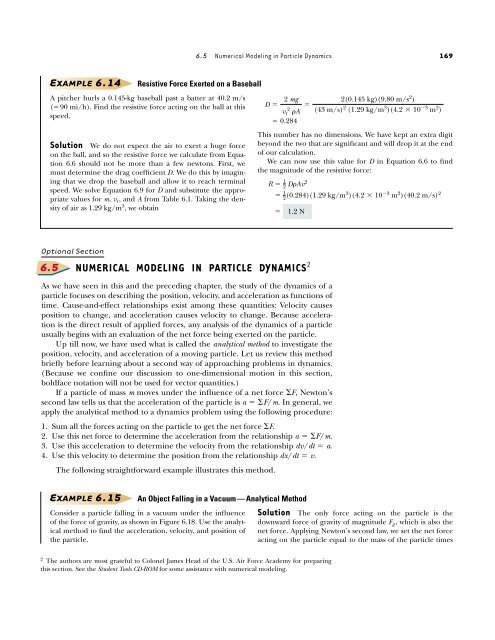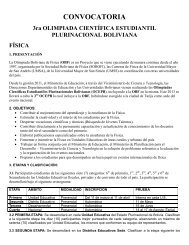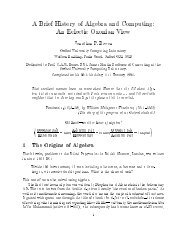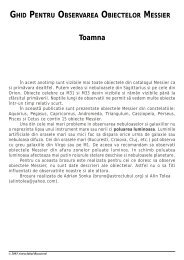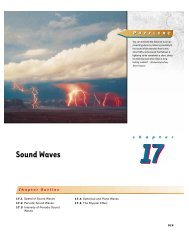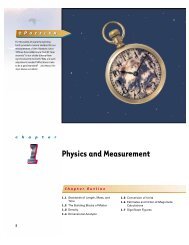Circular Motion and Other Applications of Newton's Laws
Circular Motion and Other Applications of Newton's Laws
Circular Motion and Other Applications of Newton's Laws
You also want an ePaper? Increase the reach of your titles
YUMPU automatically turns print PDFs into web optimized ePapers that Google loves.
Optional Section<br />
6.5<br />
EXAMPLE 6.14<br />
NUMERICAL MODELING IN PARTICLE DYNAMICS 2<br />
6.5 Numerical Modeling in Particle Dynamics 169<br />
Resistive Force Exerted on a Baseball<br />
A pitcher hurls a 0.145-kg baseball past a batter at 40.2 m/s<br />
(�90 mi/h). Find the resistive force acting on the ball at this<br />
speed.<br />
Solution We do not expect the air to exert a huge force<br />
on the ball, <strong>and</strong> so the resistive force we calculate from Equation<br />
6.6 should not be more than a few newtons. First, we<br />
must determine the drag coefficient D. We do this by imagining<br />
that we drop the baseball <strong>and</strong> allow it to reach terminal<br />
speed. We solve Equation 6.9 for D <strong>and</strong> substitute the appropriate<br />
values for m, v t, <strong>and</strong> A from Table 6.1. Taking the density<br />
<strong>of</strong> air as 1.29 kg/m 3 , we obtain<br />
� 0.284<br />
As we have seen in this <strong>and</strong> the preceding chapter, the study <strong>of</strong> the dynamics <strong>of</strong> a<br />
particle focuses on describing the position, velocity, <strong>and</strong> acceleration as functions <strong>of</strong><br />
time. Cause-<strong>and</strong>-effect relationships exist among these quantities: Velocity causes<br />
position to change, <strong>and</strong> acceleration causes velocity to change. Because acceleration<br />
is the direct result <strong>of</strong> applied forces, any analysis <strong>of</strong> the dynamics <strong>of</strong> a particle<br />
usually begins with an evaluation <strong>of</strong> the net force being exerted on the particle.<br />
Up till now, we have used what is called the analytical method to investigate the<br />
position, velocity, <strong>and</strong> acceleration <strong>of</strong> a moving particle. Let us review this method<br />
briefly before learning about a second way <strong>of</strong> approaching problems in dynamics.<br />
(Because we confine our discussion to one-dimensional motion in this section,<br />
boldface notation will not be used for vector quantities.)<br />
If a particle <strong>of</strong> mass m moves under the influence <strong>of</strong> a net force �F, Newton’s<br />
second law tells us that the acceleration <strong>of</strong> the particle is a ��F/m. In general, we<br />
apply the analytical method to a dynamics problem using the following procedure:<br />
1. Sum all the forces acting on the particle to get the net force �F.<br />
2. Use this net force to determine the acceleration from the relationship a ��F/m.<br />
3. Use this acceleration to determine the velocity from the relationship dv/dt � a.<br />
4. Use this velocity to determine the position from the relationship dx/dt � v.<br />
The following straightforward example illustrates this method.<br />
EXAMPLE 6.15<br />
D �<br />
This number has no dimensions. We have kept an extra digit<br />
beyond the two that are significant <strong>and</strong> will drop it at the end<br />
<strong>of</strong> our calculation.<br />
We can now use this value for D in Equation 6.6 to find<br />
the magnitude <strong>of</strong> the resistive force:<br />
� 1<br />
2 (0.284)(1.29 kg/m3 )(4.2 � 10�3 m2 )(40.2 m/s) 2<br />
R � 1<br />
2 D�Av2<br />
�<br />
2 mg<br />
�<br />
v 2<br />
t �A<br />
1.2 N<br />
An Object Falling in a Vacuum — Analytical Method<br />
Consider a particle falling in a vacuum under the influence<br />
<strong>of</strong> the force <strong>of</strong> gravity, as shown in Figure 6.18. Use the analytical<br />
method to find the acceleration, velocity, <strong>and</strong> position <strong>of</strong><br />
the particle.<br />
2 The authors are most grateful to Colonel James Head <strong>of</strong> the U.S. Air Force Academy for preparing<br />
this section. See the Student Tools CD-ROM for some assistance with numerical modeling.<br />
2(0.145 kg)(9.80 m/s 2 )<br />
(43 m/s) 2 (1.29 kg/m 3 )(4.2 � 10 �3 m 2 )<br />
Solution The only force acting on the particle is the<br />
downward force <strong>of</strong> gravity <strong>of</strong> magnitude F g, which is also the<br />
net force. Applying Newton’s second law, we set the net force<br />
acting on the particle equal to the mass <strong>of</strong> the particle times


